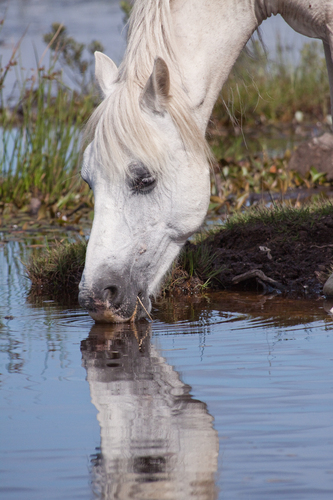According to Dr. Rachel Bourne of the Wisconsin Equine Clinic & Hospital located in Oconomowoc, Wisconsin, their clinic has treated several cases of Potomac horse fever, PHF) this year.

Natural water - Source of disease carrying snails, worms and flies
If a horse inadvertently eats flying insects carrying Neorickettsia risticii, it can become infected with Potomac horse fever.
Signs of Potomac horse fever include anorexia, depression, diarrhea (sometimes severe), fever and laminitis. If left untreated the disease can be fatal. The disease is caused by an organism called Neorickettsia risticii. The organism goes through some of it's life cycle in flatworms and snails (found in ponds) and flying insects that live close to water (mayflies, dragonflies, caddis flies).
If a horse inadvertently eats these insects they can become infected with PHF. It is not transmitted from horse to horse unlike other diarrhea-causing diseases like Salmonella. Treatment for the disease is quite successful if caught early. The initial treatment of choice is oxytetracycline IV and supportive care to manage the fluid losses from the diarrhea and to prevent against laminitis.
How can horse owners minimize risks of Potomac horse fever?
- Vaccination - vaccines for PHF are available - they do not give 100% protection as there has been some shift in the strains of the disease over the years but in endemic areas the vaccine seems to lower the degree of clinical signs in affected horses.
- Fence off natural water sources - this will keep the horse away from some of the intermediate hosts that could be ingested
- Cover your hay - keeping feed sources covered or indoors and checking for dead insects will also limit exposure to the intermediate hosts.
- Turn off barn lights at night - flies are attracted to the lights at night and will congregate and may fall into feed/water buckets. A study showed that horses at the end of the barn aisle or close to bright lights were at higher risk of contracting the disease.
- Stay abreast of the insect situation in your area - the types of insects that cause this disease will sometimes hatch in massive quantities, mate and then die leaving carcasses all around. Your local agriculture extension office may have information on these insects.
Other diseases that look like PHF include salmonellosis, clostridial diarrhea, toxin exposure. If diarrhea is noted and especially if your horse has a fever or seems depressed then your veterinarian should be contacted immediately.
